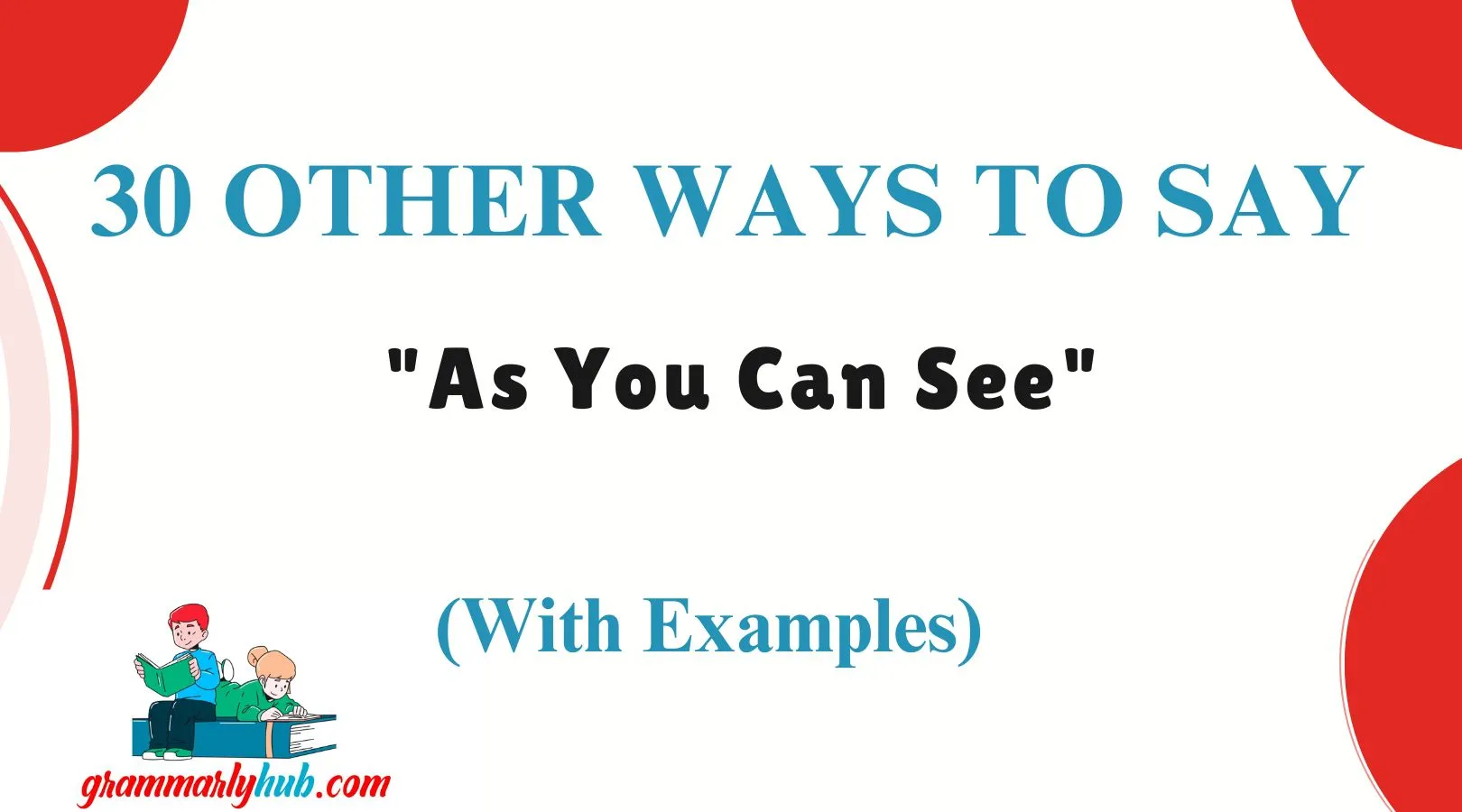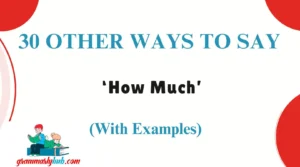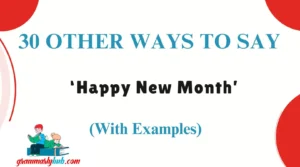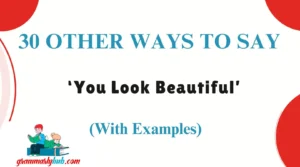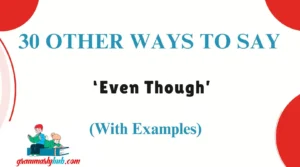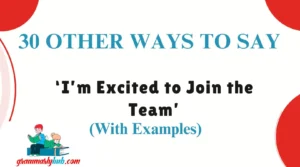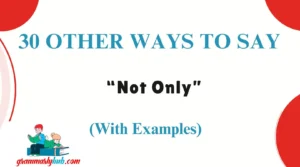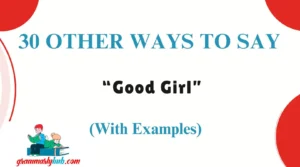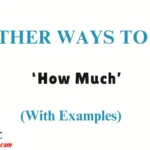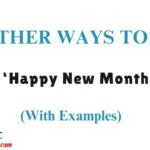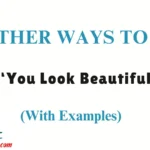Effective communication is all about clarity, empathy, and connection. Whether you’re drafting an email, writing a report, or having a conversation, choosing the right words can make a big difference. “As you can see” is a phrase often used to point out something that’s already visible or understood.
However, there are numerous alternative ways to express this idea that can make your writing feel more dynamic, engaging, and personal.
Here are 30 other ways to say “As You Can See”, each with a definition, examples, and suggestions for best use. You’ll find phrases that help you sound more engaging, professional, or even playful, depending on your context.
What Does “As You Can See” Mean?
“As you can see” is typically used when pointing out something that is already clear or evident in a context, whether it’s through writing, visuals, or prior discussion. It’s a common phrase in both professional and casual settings, used to direct attention to something that the audience should already recognize or observe.
When to Use “As You Can See”
Use “As you can see” when you want to:
- Draw attention to a visual element (such as a chart, graph, or image).
- Emphasize something that should be immediately apparent to your audience.
- Transition to making a point that is self-explanatory from the information presented.
Avoid using it in cases where the information is not immediately clear or may need further explanation.
Is It Professional/Polite to Say “As You Can See”?
Yes, “As you can see” is considered polite in many professional contexts, especially when referencing data or visual aids. However, overuse can make your communication feel redundant or too mechanical. It’s always good to mix it up with other expressions for a more natural flow.
Pros and Cons of Using “As You Can See”
Pros:
- Clear and direct.
- Works well in presentations or technical writing.
- A quick way to direct attention.
Cons:
- Can sound repetitive if overused.
- May feel impersonal or mechanical in some contexts.
- Lacks creativity and can be less engaging.
“As You Can See” Synonyms:
- As Demonstrated
- As Shown
- As Illustrated
- As Evident From
- Evidently
- It’s Clear To See
- As Displayed
- As Depicted
- As Highlighted
- As Observed
- Clearly Shown
- Visibly Evident
- As Reflected In
- As Outlined
- As Indicated
- From This, We Can Tell
- This Shows That
- It’s Clear From This That
- You’ll Notice That
- As Reflected By
- It’s Apparent That
- As Proven By
- The Evidence Shows
- It’s Obvious From This That
- Clearly Indicated
- It Becomes Clear That
- The Following Makes It Clear That
- This Makes It Evident That
- It’s Worth Noting That
- As Made Clear
1. “As Shown Above”
Definition: Directs attention to something visible in the text or image above.
Explanation: A simple and clear alternative that still keeps the attention focused on the visual aspect.
Example: As shown above, the data clearly indicates a steady increase in sales.
Best Use: When referencing something that’s visibly located above in a report or presentation.
Tone: Neutral, direct
2. “As Demonstrated”
Definition: Indicates that something has been illustrated or shown clearly.
Explanation: More formal and assertive, it’s great for emphasizing how something has been visually or methodically demonstrated.
Example: As demonstrated in the graph, the market trends have been unpredictable.
Best Use: For formal presentations or technical discussions.
Tone: Professional, informative
3. “As You Can Observe”
Definition: A slightly more formal way to say “as you can see.”
Explanation: This phrase is especially useful in presentations or discussions where you want to invite the audience to look at something specific.
Example: As you can observe from the chart, the growth has slowed down significantly.
Best Use: Academic papers, reports, or formal presentations.
Tone: Polite, observational
4. “As Evidenced By”
Definition: Suggests that something is clearly supported or proven by the information presented.
Explanation: Useful when you want to assert the credibility of the information or evidence you’re presenting.
Example: As evidenced by the latest survey results, customer satisfaction has improved.
Best Use: Legal or academic writing, research papers.
Tone: Formal, assertive
5. “As Highlighted”
Definition: Directs attention to something that has been emphasized or marked for notice.
Explanation: This phrase is great when referencing something that’s been specifically highlighted or set apart for clarity.
Example: As highlighted in the previous section, the new policy will impact staffing levels.
Best Use: Business reports, presentations, or written guides.
Tone: Clear, emphasizing
6. “As Illustrated”
Definition: Refers to something presented or depicted in a clear, illustrative way.
Explanation: This is a good alternative when referring to visual aids or examples that have been depicted in the content.
Example: As illustrated in the following slide, our revenue has grown by 15% this quarter.
Best Use: Educational materials, business presentations, training manuals.
Tone: Visual, clarifying
7. “As Seen”
Definition: A straightforward and casual way to reference something visible.
Explanation: It’s a quick and informal way to direct attention to something in the document or presentation.
Example: As seen in the bar chart, there has been a significant increase in sales this year.
Best Use: Informal emails, blog posts, or quick reports.
Tone: Casual, direct
8. “As Noted”
Definition: Indicates that something has been previously mentioned or written.
Explanation: It’s a great way to recall a point that was noted earlier in the text or conversation.
Example: As noted earlier, the new system will be launched in Q3.
Best Use: Professional emails, meetings, or summaries.
Tone: Formal, referential
9. “As Displayed”
Definition: Refers to something visually presented, typically in a clear and visible format.
Explanation: A good choice when referring to charts, images, or diagrams.
Example: As displayed on the pie chart, 60% of customers prefer our new product.
Best Use: Presentations, technical documents, or marketing materials.
Tone: Professional, clear
10. “As Can Be Seen”
Definition: A more neutral, slightly formal way of referring to something visible.
Explanation: Similar to “As you can see,” but with a bit more formality.
Example: As can be seen in the accompanying diagram, the process flow is much smoother now.
Best Use: Reports, presentations, formal writing.
Tone: Neutral, formal
11. Clearly Shown
Definition: Points to something that is obvious or unmistakable in the visual or context.
Explanation: A straightforward phrase that helps reinforce clarity and confidence in what you’re presenting.
Example: The benefits of this approach are clearly shown in the feedback data.
Worst Use: When the point is unclear or debatable — it may seem presumptuous.
Tone: Confident, matter-of-fact
12. Visibly Evident
Definition: Refers to something that is plain and visible to the eye.
Explanation: Slightly formal, this version emphasizes that something is undeniably clear from visual inspection or results.
Example: The difference in user engagement is visibly evident in the two campaigns.
Worst Use: In casual emails — it may sound overly formal or stiff.
Tone: Formal, assured
13. As Reflected In
Definition: Suggests something is shown or mirrored in data or visuals.
Explanation: Great when you’re referring to results, outcomes, or feedback that reflect a trend or idea.
Example: As reflected in our Q2 metrics, user retention is steadily improving.
Worst Use: For abstract ideas that aren’t clearly measurable.
Tone: Professional, analytical
14. As Outlined
Definition: Refers to something previously structured or laid out in writing or visuals.
Explanation: Best for formal documents or presentations where you’ve outlined points or steps clearly.
Example: As outlined in the previous section, we aim to expand our outreach next quarter.
Worst Use: When no actual outline has been provided — can confuse readers.
Tone: Structured, formal
15. As Indicated
Definition: Suggests that something has already been shown or pointed to.
Explanation: A clean, polished phrase that works well in data-driven or academic contexts.
Example: As indicated by the graph, user traffic increased after the update.
Worst Use: In overly casual speech — may come off as too technical.
Tone: Academic, measured
16. From This, We Can Tell
Definition: Highlights a conclusion drawn directly from the presented information.
Explanation: This phrase involves the audience in the reasoning process and helps build logical flow in your writing or speech.
Example: From this, we can tell that customer behavior shifts with seasonal trends.
Worst Use: In formal writing — it’s more conversational and may feel too casual.
Tone: Inclusive, logical
17. This Shows That
Definition: Emphasizes that the previous content proves or demonstrates a point.
Explanation: A widely used alternative that transitions smoothly from evidence to insight.
Example: This shows that employee engagement is closely tied to transparency.
Worst Use: When the connection is not clear — it can appear vague or forced.
Tone: Clear, explanatory
18. It’s Clear From This That
Definition: Stresses obviousness or clarity of the point being made.
Explanation: Good for driving home a point that you believe should be plainly understood from your materials.
Example: It’s clear from this that early intervention led to better outcomes.
Worst Use: When the point is actually unclear or could be disputed.
Tone: Assertive, persuasive
19. You’ll Notice That
Definition: A conversational phrase that directs attention to a specific observation.
Explanation: Encourages the audience to look closely and notice something specific without sounding formal or mechanical.
Example: You’ll notice that the interface is now cleaner and more intuitive.
Worst Use: Highly formal documents — it may come across as too relaxed.
Tone: Friendly, observational
20. As Reflected By
Definition: Indicates that a visual or data point mirrors the conclusion or idea being discussed.
Explanation: Useful for analytical writing or where a concept is being reinforced by numbers or feedback.
Example: As reflected by the user survey, the new onboarding process is more effective.
Worst Use: In purely visual contexts with no data — may sound mismatched.
Tone: Data-driven, credible
21. It’s Apparent That
Definition: States that something is obviously true based on what’s been presented.
Explanation: A more formal phrase that works well when pointing to clear trends, outcomes, or insights.
Example: It’s apparent that the new strategy is resonating with customers.
Worst Use: When the information isn’t actually clear — it may sound overconfident.
Tone: Confident, formal
22. As Proven By
Definition: Highlights that something has been supported by strong evidence or results.
Explanation: This phrase carries weight and is ideal when you’re referencing measurable or tested information.
Example: As proven by last quarter’s numbers, the initiative increased revenue.
Worst Use: When the evidence is weak or anecdotal.
Tone: Credible, assertive
23. The Evidence Shows
Definition: Points to supporting facts or data that validate your statement.
Explanation: Great for academic, technical, or persuasive contexts where logic and evidence matter most.
Example: The evidence shows that remote work improves productivity.
Worst Use: In casual settings — can sound too rigid or formal.
Tone: Analytical, trustworthy
24. It’s Obvious From This That
Definition: A strong way to say something should be immediately clear from the given context.
Explanation: Best used when you’re sure the point is well-supported and visually or contextually evident.
Example: It’s obvious from this that we’ve made substantial progress.
Worst Use: If your audience might disagree — it can come across as dismissive.
Tone: Direct, assertive
25. Clearly Indicated
Definition: Suggests that the data or visuals point explicitly to a conclusion.
Explanation: A great fit for professional documents and presentations with clear visual data.
Example: The timeline clearly indicated a faster completion rate this year.
Worst Use: Informal conversations or non-data-based writing.
Tone: Professional, precise
26. It Becomes Clear That
Definition: Suggests that something is starting to reveal itself through the context or data.
Explanation: This phrase is ideal when you’re walking your reader through a discovery or realization process.
Example: It becomes clear that user engagement improves with faster load times.
Worst Use: When the message is already blatantly obvious — it may feel overly wordy.
Tone: Reflective, informative
27. The Following Makes It Clear That
Definition: Introduces content that is meant to provide clarity or support a point.
Explanation: Often used to preface data, explanations, or visuals in formal or persuasive writing.
Example: The following makes it clear that the strategy needs adjusting.
Worst Use: In fast-paced or conversational writing — feels too formal or staged.
Tone: Formal, introductory
28. This Makes It Evident That
Definition: Connects a visual or statement to an evident conclusion.
Explanation: Adds strength to your claim while keeping a calm, professional tone.
Example: This makes it evident that automation has reduced response times.
Worst Use: If the information is open to interpretation.
Tone: Balanced, professional
29. It’s Worth Noting That
Definition: Emphasizes that the upcoming point deserves attention or recognition.
Explanation: This softer alternative draws attention without being too assertive or presumptive.
Example: It’s worth noting that retention rates improved after the new onboarding feature was launched.
Worst Use: When stating something trivial — it could dilute impact.
Tone: Thoughtful, encouraging
30. As Made Clear
Definition: Indicates that something has already been clarified or demonstrated.
Explanation: This phrase is especially effective in summaries or when concluding a series of points.
Example: As made clear in the report, the pilot program exceeded expectations.
Worst Use: In casual speech or when clarity hasn’t truly been established.
Tone: Conclusive, formal
Frequently Asked Questions
1. Why should I avoid repeating “As You Can See” too often?
Using the same phrase repeatedly can make your writing feel monotonous or robotic. By varying your language, you make your message more engaging, professional, and reader-friendly.
2. Are these alternatives suitable for formal writing or business emails?
Yes! Many of these phrases—such as “As Demonstrated“, “As Indicated”, or “Clearly Shown”—are perfect for reports, presentations, academic writing, and professional emails.
3. What’s the most conversational alternative to “As You Can See”?
Phrases like “You’ll Notice That” or “From This, We Can Tell” work great in casual or conversational tones, like blog posts or internal updates.
4. How do I know which alternative to choose?
Consider your audience, tone, and context. For formal settings, opt for “As Proven By” or “As Outlined”. For more approachable tones, try “It’s Worth Noting That” or “This Shows That”.
5. Can using varied phrases improve my SEO and readability score?
Absolutely. Search engines reward natural language and semantic variety. Using diverse phrases also boosts readability, helps keep your audience engaged, and aligns with AEO (Answer Engine Optimization) best practices.
Conclusion
Whether you’re writing a report, presenting data, or simply guiding someone through a point, varying how you say “As You Can See” can make your communication feel more engaging, thoughtful, and tailored to your audience. From formal options like “As Demonstrated“ to warm and conversational alternatives like “You’ll Notice That”, these expressions help you connect better and communicate with clarity.

Welcome to GrammarlyHub, your go-to destination for mastering grammar, improving your writing, and finding the best language tools available online. Founded by Emma Rose, a passionate writer and advocate for clear communication, GrammarlyHub was built to help people express themselves with confidence and accuracy.
